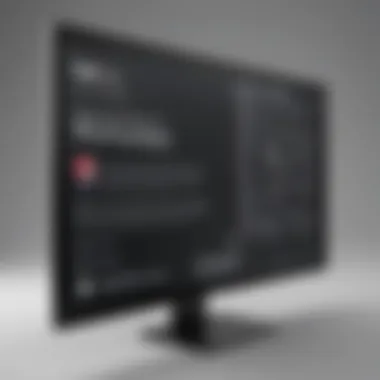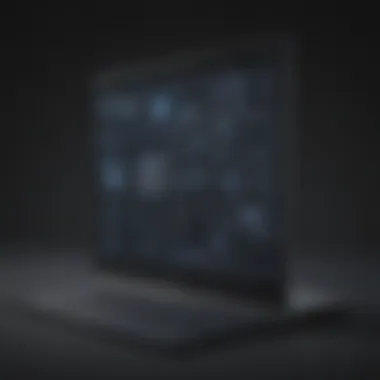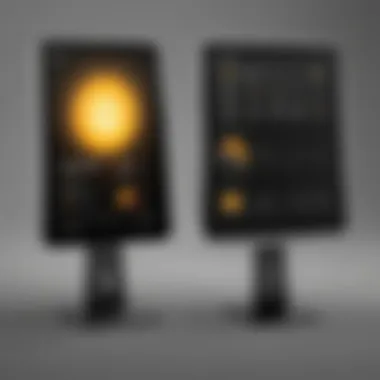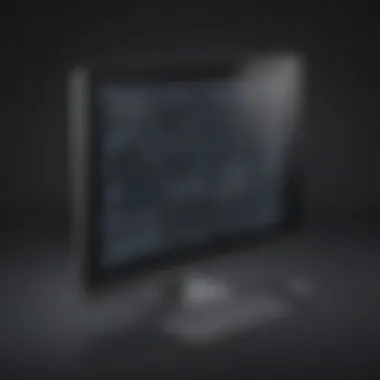Unveiling the Influence of Dark Window Screens on Consumer Tech Evolution


Product Overview
When delving into the impact of dark window screens on consumer technology, it is essential to grasp the intricate layers that influence user experience. The contrast between traditional light screens and the emerging preference for darker shades embodies a significant shift in tech aesthetics. Key features such as brightness levels, contrast ratios, and color representation play a pivotal role in the viewing quality of devices utilizing dark window screens.
Performance and User Experience
Conducting hands-on testing unveils the nuances of how dark window screens affect performance in various lighting conditions. The user interface intricacies, including readability and comfort, become apparent through prolonged usage. Comparisons with conventional screens underline the adaptability and viability of dark screens in enhancing user immersion.
Design and Build Quality
A meticulous analysis of design elements reveals the profound impact of dark window screens on the overall product identity. The choice of materials and their durability underpins the longevity of devices incorporating this screen technology. Additionally, ergonomic considerations and aesthetic appeal play a crucial role in determining consumer acceptance and satisfaction.
Technology and Innovation
Exploration of groundbreaking technology underpinning dark window screens showcases the evolutionary trajectory of consumer tech. Unique features embedded in these screens have the potential to redefine industry standards and influence future product developments. Anticipating trends in similar products underscores the dynamic nature of technological innovation in addressing user preferences.
Pricing and Value Proposition
Navigating the pricing landscape vis-a-vis the value proposition elucidates the affordability and competitiveness of dark screen technology. Comparative assessments with competitor offerings provide a comprehensive view of the market positioning of devices featuring these screens. Recommendations stemming from an amalgamation of usability, performance, and pricing considerations culminate in a final verdict that reflects the consumer utility and desirability of dark window screens.
Introduction to Dark Window Screens
In today's fast-paced technological landscape, the introduction of dark window screens has sparked great interest and debate among tech enthusiasts and industry professionals alike. These screens play a pivotal role in shaping the user experience of devices, offering unique advantages and challenges. Understanding the nuances of dark window screens is essential for individuals seeking to optimize their tech interaction and environment. By delving into the intricacies of dark window screens, we can unravel the impact they have on consumer technology and how they are reshaping the way we engage with our devices.
Understanding the Concept of Dark Window Screens
Definition and Purpose of Dark Window Screens
The definition and purpose of dark window screens encompass the core essence of this innovative technology. Dark window screens are designed to reduce glare, reflection, and external light interference on device screens. This key characteristic makes them a popular choice for individuals who prioritize screen visibility and user experience. The unique feature of dark window screens lies in their ability to enhance viewing comfort and minimize distractions, thereby improving overall user satisfaction. However, it is crucial to acknowledge that while dark window screens offer advantages in optimizing screen performance, they may sometimes impact color accuracy and vibrancy.
Evolution of Window Screen Technology
The evolution of window screen technology mirrors the advancements in consumer electronics and digital displays. As technology progresses, so do the materials and design principles used in window screens. This evolution has led to the development of darker screens that cater to specific user needs and preferences. The key characteristic of this evolution is the focus on improving screen readability and reducing eye strain in various lighting conditions. While dark window screens have become a beneficial choice for tech enthusiasts seeking enhanced screen visibility, it is important to consider potential drawbacks such as color distortion and compromised visual accuracy in graphic design work.


Types of Dark Window Screens
Static vs. Dynamic Screens
The distinction between static and dynamic screens lies at the heart of choosing the right dark window screen for individual preferences and requirements. Static screens offer a fixed level of darkness, providing consistent light reduction in diverse environments. On the other hand, dynamic screens have the ability to adjust darkness based on ambient light levels, offering a more adaptive viewing experience. The key characteristic between dynamic and static screens is the flexibility they provide in controlling screen brightness and visibility. While dynamic screens are popular for their automatic adjustment feature, static screens are favored for their simplicity and reliability.
Popular Materials Used in Dark Screens
The choice of materials used in dark screens greatly influences their performance and durability in tech settings. Popular materials such as anti-glare coatings, optical filters, and polarized layers are extensively incorporated to optimize screen clarity and reduce reflections. The key characteristic of these materials is their capacity to enhance screen visibility and protect against screen snoopers. However
Benefits of Dark Window Screens for Tech Enthusiasts
Dark window screens play a crucial role in enhancing the user experience for tech enthusiasts. These screens contribute significantly by reducing glare and reflections, ultimately improving the overall viewing experience and ensuring screen visibility even in bright environments. As technology continues to advance, the importance of dark window screens becomes more apparent, providing users with a range of benefits and considerations to optimize their tech interactions.
Reduced Glare and Reflection
Enhanced Viewing Experience
The concept of an enhanced viewing experience is paramount in the realm of technology. Dark window screens help in reducing glare, creating a more comfortable visual setting that allows users to engage with their devices without straining their eyes. This feature is particularly beneficial for individuals who spend extended periods in front of screens, ensuring not only visual comfort but also enhancing the overall viewing pleasure. The unique aspect of an enhanced viewing experience lies in its ability to maintain screen clarity while minimizing harsh reflections, resulting in a more immersive and enjoyable tech experience.
Improved Screen Visibility in Bright Environments
When discussing improved screen visibility in bright environments, the focus shifts to the adaptability of dark window screens. These screens are designed to maintain optimal visibility even when exposed to bright light conditions, ensuring that users can interact with their devices effortlessly regardless of external lighting factors. The key characteristic of improved screen visibility lies in the advanced materials used in dark screens, which mitigate the impact of brightness and reflections, offering users clear and uninterrupted access to their digital content. While this feature is popular among tech enthusiasts, it's essential to consider any potential drawbacks, such as decreased color accuracy, when utilizing dark window screens.
Enhanced Privacy and Security
Prevention of Screen Snooping
Privacy is a significant concern in today's interconnected world, and dark window screens play a vital role in preventing screen snooping. By reducing the visibility of on-screen content from side angles, these screens safeguard sensitive information from prying eyes, offering users a sense of security and confidentiality. The unique feature of preventing screen snooping is particularly advantageous for individuals working in shared spaces or high-traffic areas, ensuring that their digital activities remain private and protected.
Protection Against Prying Eyes
In addition to preventing screen snooping, dark window screens provide protection against prying eyes by limiting the viewing angles of on-screen data. This added layer of security enhances user confidence in their tech usage, especially when handling confidential or personal information. The key characteristic of protection against prying eyes lies in the innovative screen materials that obscure visibility without compromising on display quality. While this feature offers evident advantages in maintaining privacy, users should also be aware of any potential limitations, such as reduced screen brightness, which may impact overall viewing quality.


Drawbacks of Dark Window Screens in Tech Settings (300-400 words)
Dark window screens in tech settings present certain drawbacks that need to be carefully considered. One significant downside is the diminished color accuracy that these screens may cause, affecting tasks such as photo and video editing, where precise color representation is crucial. This dimming effect can lead to color distortion, potentially impacting the quality and accuracy of graphic design work. Furthermore, prolonged use of dark screens can contribute to eye strain issues, which can have long-term effects on vision.
Diminished Color Accuracy (250-300 words)
Impact on Photo and Video Editing:
The impact of dark window screens on photo and video editing is profound. The subdued brightness of dark screens can alter color perception, leading to inaccuracies in editing decisions. In tasks that demand color precision, such as adjusting skin tones or landscapes, this altered color representation can distort the final outcome. This challenge poses a significant hurdle for professionals seeking color accuracy in their visual work, affecting the overall quality of their projects.
Color Distortion in Graphic Design Work:
When it comes to graphic design work, color distortion due to dark window screens is a critical concern. Designers rely on accurate color reproduction for branding, digital art, and other visual aspects. Dark screens can skew color values, rendering shades differently than intended. This discrepancy can be detrimental to the impact and effectiveness of design pieces, potentially compromising the messaging and aesthetics of the final product.
Potential Eye Strain Issues (250-300 words)
Long-Term Effects on Vision:
The lasting impact of dark window screens on vision health should not be underestimated. Consistently staring at screens with reduced brightness can strain the eyes over time, leading to discomfort, headaches, and potential long-term vision issues. The extended exposure to dimly lit displays may contribute to eye fatigue, affecting overall visual acuity and eye health.
Strategies to Combat Eye Fatigue:
Efficient strategies to combat eye fatigue in dark screen environments are imperative. Regular breaks, proper screen brightness adjustments, and utilizing blue light filters can help alleviate strain on the eyes. These proactive measures can enhance eye comfort and reduce the risk of long-term vision problems associated with prolonged screen exposure, promoting healthier viewing practices.
Implications of Dark Window Screens on Device Performance
Dark window screens play a crucial role in influencing the performance of consumer technology devices. The impact of these screens on device functionality is multifaceted, affecting various aspects that tech enthusiasts should consider. By choosing appropriate dark window screens, users can effectively manage factors such as glare reduction, privacy enhancement, and even energy efficiency. Understanding the implications of dark window screens on device performance is paramount for individuals seeking optimal tech experiences.
Temperature Regulation Concerns
Effects on Device Heating and Cooling
One primary consideration regarding dark window screens is their impact on the heating and cooling processes of electronic devices. These screens can influence the thermal dynamics of devices by either absorbing or reflecting heat. The ability of dark screens to absorb heat can sometimes lead to increased temperatures within device enclosures. However, their reflective properties can also help dissipate heat, contributing to a better thermal equilibrium within electronics. The choice between absorption and reflection depends on the design of the device and the desired temperature control.


Mitigating Thermal Impact with Dark Screens
In addressing the potential thermal impacts of dark window screens, mitigating strategies become essential. Manufacturers often integrate thermal management features within devices to counteract any excessive heating caused by dark screens. By utilizing materials with high thermal conductivity or incorporating cooling mechanisms, devices can maintain optimal operating temperatures. Additionally, implementing advanced heat dissipation technologies like heat pipes or thermal interface materials can further enhance the efficiency of dark window screens in regulating device temperatures.
Battery Life Considerations
Influence of Screen Darkness on Battery Consumption
The darkness level of window screens can significantly affect the battery consumption of electronic devices. Dark screens generally consume less power compared to brighter alternatives, as they require lower levels of backlighting. This reduced power demand contributes to prolonged battery life, benefiting users who require extended device usage without frequent recharging. Selecting the optimal screen darkness to balance visibility and power efficiency is crucial for maximizing battery performance in tech gadgets.
Optimizing Power Usage in Dark Screen Environments
Optimizing power consumption in settings with dark window screens involves leveraging the screen darkness to enhance battery efficiency. Device manufacturers often fine-tune power management settings to align with the darkness levels of the screens. By adjusting backlight intensity, display refresh rates, and other power-saving features, devices can prolong battery life without compromising user experience. The synergy between dark screens and power optimization strategies is essential for ensuring sustained device performance and user satisfaction.
Exploring Future Innovations in Dark Window Screen Technology
Describing the significance of delving into future innovations in dark window screen technology within the context of this extensive article is crucial for providing a holistic understanding of the subject matter. By focusing on advancements in this niche area, we shed light on the potential evolution and impact of dark screens on consumer technology. The discussion surrounding the exploration of future innovations aims to highlight the latest trends, cutting-edge technologies, and pioneering concepts that may shape the tech landscape. Offering insights into emerging solutions and novel approaches, this section serves as a forward-looking glimpse into the possibilities that dark window screens hold for tech enthusiasts and industry stakeholders.
Integration with Smart Devices
AI-Enabled Adaptive Screen Darkness
Diving into the realm of AI-enabled adaptive screen darkness is a pivotal aspect within the broader exploration of future innovations in dark window screen technology. This subsection delves into how artificial intelligence is leveraged to dynamically adjust screen brightness based on environmental conditions and user preferences. The key characteristic of AI-enabled adaptive screen darkness lies in its ability to enhance user experience by optimizing visual clarity and comfort. The unique feature of this technology is its capacity to intelligently adapt to varying lighting scenarios, providing users with optimal viewing conditions. While offering undeniable benefits in terms of usability and convenience, it also raises considerations regarding privacy and data security in this era of interconnected smart devices.
Io
T Connectivity for Automated Adjustment
Further elaborating on future innovations, the integration of Io T connectivity for automated adjustment of dark window screens is a groundbreaking development explored in this section. Highlighting the integration of Internet of Things (IoT) technology, this feature enables seamless communication between devices for real-time adjustments based on ambient light levels and user behavior. The key characteristic of IoT connectivity lies in its ability to create a network of interconnected devices that collectively enhance the functionality and performance of dark screens. This automated adjustment mechanism offers users unparalleled convenience and customization options, contributing to a more connected and intuitive tech ecosystem. However, it also prompts considerations around data privacy, cybersecurity, and the potential complexities associated with managing interconnected devices in a smart environment.
Advancements in Energy-Efficient Materials
Solar-Powered Dark Screens
Discussing the integration of solar-powered dark screens represents a significant leap in advancing energy-efficient solutions in dark window screen technology. This subsection explores how harnessing solar energy to power dark screens can contribute to sustainability and eco-friendliness in tech interactions. The key characteristic of solar-powered dark screens lies in their ability to operate autonomously, utilizing renewable energy sources to reduce environmental impact and energy consumption. This unique feature positions solar-powered screens as a green alternative for tech enthusiasts seeking eco-friendly solutions. While offering advantages in terms of sustainability and energy efficiency, it also raises considerations regarding the practicality and effectiveness of solar energy integration in powering dark screens on a consistent basis.
Eco-friendly Alternatives for Sustainable Tech Interaction
Highlighting eco-friendly alternatives for sustainable tech interaction is a segment that underscores the importance of environmentally conscious practices in the realm of consumer technology. This section delves into innovative materials and approaches that prioritize sustainability, such as biodegradable components and recyclable resources. The key characteristic of eco-friendly alternatives lies in their commitment to reducing environmental impact throughout the lifecycle of tech products, from manufacturing to disposal. By promoting sustainability and responsible consumption, these alternatives offer long-term benefits for both users and the planet. However, considerations arise concerning the feasibility of widespread adoption, cost implications, and consumer awareness of eco-friendly initiatives.



